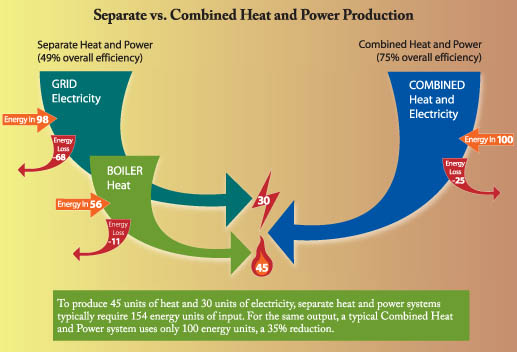Cornell plans heating plant upgrade that will cut greenhouse gas emissions by 20 percent
By Lauren Gold

In a move that the Environmental Protection Agency (EPA) hails as "exceptional leadership in energy use and management," Cornell University today announced a planned upgrade of the university's combined heat and power (CHP) system to adapt to growing demand while reducing the university's impact on the environment.
The system will use gas turbine technology to generate heat and electricity from a single source, drastically cutting waste in energy production and providing a cleaner, more efficient and reliable energy supply for campus. It will reduce regional emissions of carbon dioxide (CO2) from campus heat and electricity use, by 20 percent. CO2 is a leading greenhouse gas, and the reduction is equivalent to removing 8,260 cars from the road. This will put Cornell in line with the environmental goals agreed upon by 174 nations at the 1997 Kyoto Climate Change Conference in Japan, said Zellman Warhaft, Cornell professor of mechanical and aerospace engineering.
"This is a very positive step in reducing emissions of carbon dioxide, as well as other emissions like nitrogen and sulfur oxides," he said "This is progress in the right direction."
Faced with aging facilities and a changing campus, the university evaluated a wide variety of options and concluded that upgrading the CHP system -- a concept Cornell has been using on a smaller scale since 1986 -- is the most environmentally and fiscally responsible option at present. The administration continues to explore such renewable energy sources as wind, solar power and biomass, noted Cornell sustainability coordinator Dean Koyanagi, and remains open to pursuing such options if they become more feasible in the future.
The new CHP system includes gas combustion turbines to provide the power necessary to turn two large electricity generators. The heat exhausted from the combustion turbines -- wasted in a conventional electric power plant -- will then generate steam in heat recovery steam generators. The steam will pass through the existing steam turbine generators in the central heating plant before moving on to heat campus buildings.
The current steam turbine generators, along with a small hydroelectric plant (both of which will remain in service), supply 15 percent of Cornell's power. "The Combined Heat and Power project will enhance the existing cogeneration capability to provide about 80 percent of the electricity needed for campus," said Jim Adams, Cornell's director of utilities and energy management. "Benefits of this project include increasing Cornell's fuel flexibility, improving the reliability of electricity and heat, reducing emissions and providing for future campus heating needs."
CHP systems have been installed recently at the Massachusetts Institute of Technology, Princeton University and the University of Michigan. In a letter to Cornell about the proposed upgrade, EPA spokesperson Katrina Pielli said the agency calculated that Cornell's improved system will reduce CO2 emissions by 20 percent, or greater than 50,000 tons per year, and sulfur and nitrogen oxide emissions by 50 percent.
"Based on this analysis, the CHP system will have an impressive emission reduction impact," Pielli wrote.
"Increased efficiency will reduce CO2 emissions, which add to global warming," Warhaft said. Cornell has pledged to strive toward compliance with the Kyoto accord, he added, "so this is a very positive step. Reducing coal emissions will also strongly reduce emissions. This adds to the other wonderful projects, which include Lake Source Cooling and also the revamping of many of the buildings on campus to become more energy efficient."
"We're very excited to hear that this change is going to bring us in line with the Kyoto goal," said Emily Rochon, a graduate student in environmental toxicology and president of the student environmental group Kyoto Now! "From an efficiency standpoint [CHP] makes great sense," Rochon said. "The waste heat is going to be there. We may as well use it."
Members of Kyoto Now! will still encourage Cornell to explore future use of renewable energy sources, she said.
The project, expected to be completed no later than 2009, will include construction of two new gas turbine generators to be housed in a 15,000-square-foot addition behind the current central heating plant on Route 366. The system might also be capable of burning multiple fuels to increase reliability and adapt to the evolving market.
But the Cornell community must still do its part to conserve energy wherever possible, Warhaft said. "These extensive innovations in technology that Cornell is using are in vain unless the community plays its role in conserving energy," he added.
Koyanagi agreed. "That's been one of the hardest things -- getting people to reduce electric loads and act judiciously in the use of heat and air conditioning," he said. "Anything we do on the supply side makes people think about what they're doing on the demand side. It's going to start the dialogue toward bigger and better things."
Of the CHP expansion project, Koyanagi said: "I'm pleased. They're thinking about the long term.
"Conservation efforts, Lake Source Cooling and community awareness will also help reduce the university's ecological impact. It's a significant step."
Media Contact
Get Cornell news delivered right to your inbox.
Subscribe